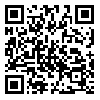Volume 20, Issue 1 (March 2024)
IJEEE 2024, 20(1): 55-70 |
Back to browse issues page
Abstract: (467 Views)
Cognitive radio (CR) is an effective technique for dealing with scarcity in spectrum resources and enhancing overall spectrum utilization. CR attempts to enhance spectrum sensing by detecting the primary user (PU) and allowing the secondary user (SU) to utilize the spectrum holes. The rapid growth of CR technology increases the required standards for Spectrum Sensing (SS) performance, especially in regions with low Signal-to-Noise Ratios (SNRs). In Cognitive Radio Networks (CRN), SS is an essential process for detecting the available spectrum. SS is divided into sensing time and transmission time; the more the sensing time, the higher the detection probability) and the lower the probability of a false alarm). So, this paper proposes a novel two-stage SS optimization model for CR systems. The proposed model consists of two techniques: Interval Dependent De-noising (IDD) and Energy Detection (ED), which achieve optimum sensing time, maximum throughput, lower and higher. The Simulation results demonstrated that the proposed model decreases the, achieves a higher especially at low SNRs ranging, and obtains the optimum sensing time, achieving maximum throughput at different numbers of sensing samples (N) and different SNRs from -10 to -20 dB in the case of N = 1000 to 10000 samples. The proposed model achieves a throughput of 5.418 and 1.98 Bits/Sec/HZ at an optimum sensing time of 0.5ms and 1.5ms respectively, when N increases from 10000 to 100000 samples. The proposed model yields an achievable throughput of 5.37 and 4.58 Bits/Sec/HZ at an optimum sensing time of 1.66ms and 13ms respectively. So, it enhances the SS process than previous related techniques.
Type of Study: Research Paper |
Subject:
Communication Systems
Received: 2023/08/15 | Revised: 2024/06/10 | Accepted: 2024/02/28
Received: 2023/08/15 | Revised: 2024/06/10 | Accepted: 2024/02/28
| Rights and permissions | |
 |
This work is licensed under a Creative Commons Attribution-NonCommercial 4.0 International License. |



